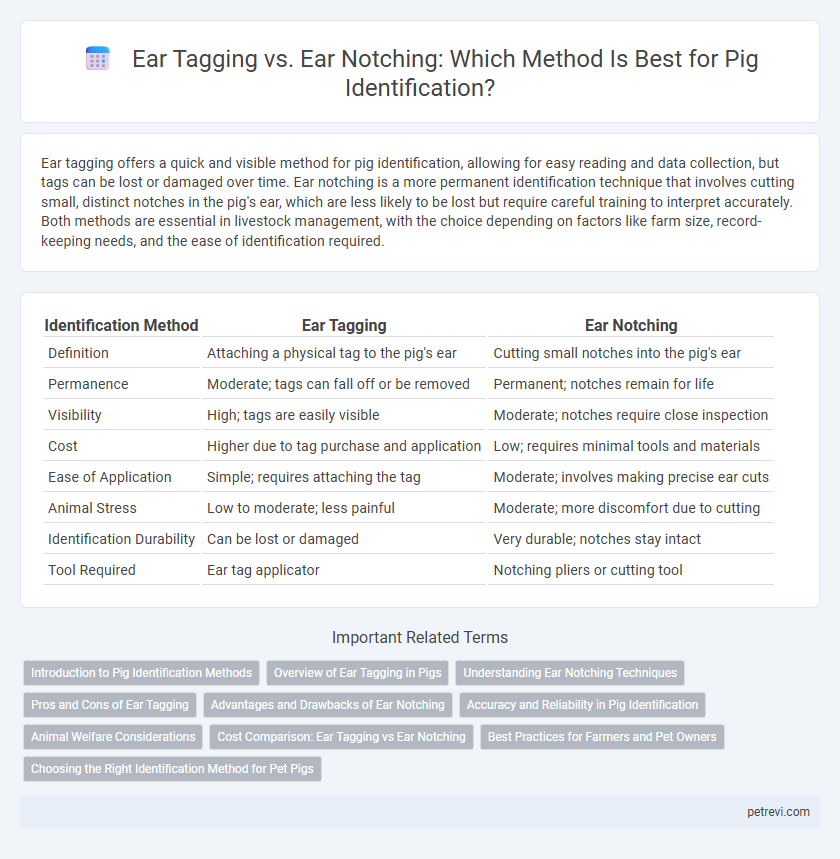Ear tagging offers a quick and visible method for pig identification, allowing for easy reading and data collection, but tags can be lost or damaged over time. Ear notching is a more permanent identification technique that involves cutting small, distinct notches in the pig's ear, which are less likely to be lost but require careful training to interpret accurately. Both methods are essential in livestock management, with the choice depending on factors like farm size, record-keeping needs, and the ease of identification required.
Table of Comparison
| Identification Method | Ear Tagging | Ear Notching |
|---|---|---|
| Definition | Attaching a physical tag to the pig's ear | Cutting small notches into the pig's ear |
| Permanence | Moderate; tags can fall off or be removed | Permanent; notches remain for life |
| Visibility | High; tags are easily visible | Moderate; notches require close inspection |
| Cost | Higher due to tag purchase and application | Low; requires minimal tools and materials |
| Ease of Application | Simple; requires attaching the tag | Moderate; involves making precise ear cuts |
| Animal Stress | Low to moderate; less painful | Moderate; more discomfort due to cutting |
| Identification Durability | Can be lost or damaged | Very durable; notches stay intact |
| Tool Required | Ear tag applicator | Notching pliers or cutting tool |
Introduction to Pig Identification Methods
Ear tagging and ear notching are two primary methods used for pig identification, each offering distinct advantages in durability and visibility. Ear tagging involves attaching a plastic or metal tag with unique identification numbers, ensuring easy, quick visual recognition and data tracking on commercial farms. Ear notching, on the other hand, uses a standardized pattern of cuts on the pig's ear to provide permanent, tamper-proof identification that remains legible even in harsh rearing conditions.
Overview of Ear Tagging in Pigs
Ear tagging in pigs involves attaching a durable plastic or metal tag to the animal's ear, providing a visible and easily readable identification method essential for tracking health, breeding, and ownership. This technique enables quick visual identification in large herds and supports management practices such as vaccination records and growth monitoring. Compared to other identification methods, ear tags offer a balance of durability, cost-effectiveness, and minimal impact on pig welfare.
Understanding Ear Notching Techniques
Ear notching is a widely used pig identification technique involving specific cuts on the edges of a pig's ear, each notch representing a unique identification code based on numerical values assigned to different ear sections. This method allows for durable and clear identification, even in harsh farm environments where tags may be lost or damaged. Compared to ear tagging, ear notching offers a permanent, low-cost solution that facilitates traceability and record-keeping across pig production systems.
Pros and Cons of Ear Tagging
Ear tagging in pigs enables quick visual identification and traceability, improving farm management and disease control. However, tags can fall off or become damaged, leading to potential loss of identification data and the need for replacement. While less invasive than ear notching, ear tagging may cause minor discomfort or infection risks at the insertion site if not properly maintained.
Advantages and Drawbacks of Ear Notching
Ear notching in pig identification offers a permanent and cost-effective method that does not require additional equipment compared to ear tagging. This technique ensures durability since notches cannot be lost or removed, providing reliable long-term identification for swine management. However, ear notching can cause more immediate pain and stress to the pig, and the limited number of notch combinations may restrict identification options for large herds.
Accuracy and Reliability in Pig Identification
Ear tagging offers higher accuracy and reliability in pig identification due to its clear visibility and ease of scanning with electronic devices, reducing human error during data collection. Ear notching, while cost-effective, can be less precise as the notches may fade or be difficult to distinguish over time, leading to potential misidentification. For long-term tracking in large herds, ear tagging provides a more dependable method, ensuring consistent individual pig identification.
Animal Welfare Considerations
Ear tagging in pigs allows for quick identification with minimal tissue damage, but tags can sometimes cause irritation or get caught, potentially leading to injury or infection. Ear notching, while permanent and less likely to be lost, involves cutting small sections of the ear, which may cause immediate pain and stress to the animal if not done properly. Proper hygiene, pain management, and skilled application are essential to minimize welfare concerns in both identification methods.
Cost Comparison: Ear Tagging vs Ear Notching
Ear tagging for pig identification generally incurs higher initial costs due to the purchase of tags and applicators, whereas ear notching relies on inexpensive tools and is virtually cost-free per animal. Maintenance expenses for ear tags include replacement costs if tags fall off or become damaged, which can accumulate over time. Ear notching, while requiring trained personnel for accurate identification, eliminates ongoing material costs, making it more economical for large-scale pig farming operations.
Best Practices for Farmers and Pet Owners
Ear tagging provides clear, visible identification with minimal pain and allows easy scanning for traceability, making it ideal for large-scale pig farms. Ear notching offers a permanent, cost-effective method but requires skillful application to avoid infection and ensure accurate information recording. Farmers and pet owners should balance ease of use, animal welfare, and record accuracy when choosing between these identification methods.
Choosing the Right Identification Method for Pet Pigs
Ear tagging offers easy visual identification and can be customized with numbers or barcodes, making it ideal for pet pigs with frequent human interaction. Ear notching provides a permanent, cost-effective method but may cause more discomfort and requires training for accurate interpretation of the notch codes. For pet pigs, consider animal welfare, ease of identification, and record-keeping needs when selecting between ear tagging and ear notching.
Ear tagging vs Ear notching for Pig identification Infographic

 petrevi.com
petrevi.com